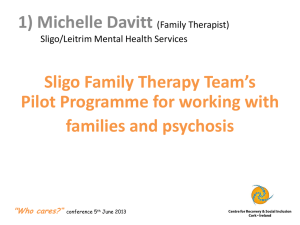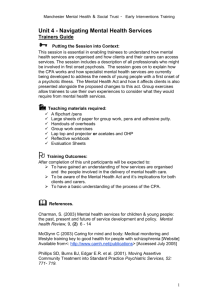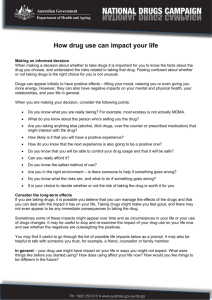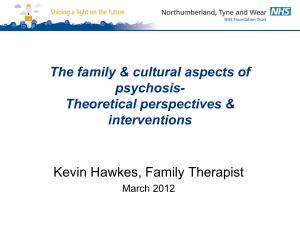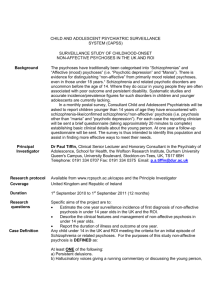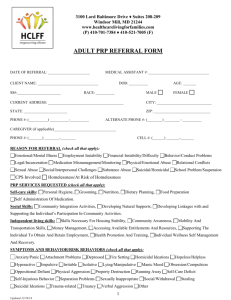Predicting psychosis using neurobiology: Where are we now? [PPT
advertisement
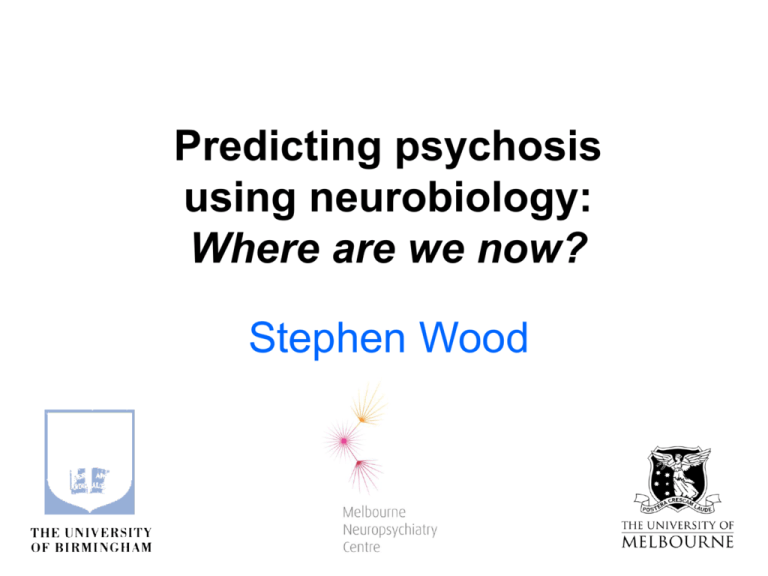
Predicting psychosis using neurobiology: Where are we now? Stephen Wood Acknowledgements… • • • • • • • NHMRC (Australia) NARSAD Prof Chris Pantelis Prof Pat McGorry Dr Dennis Velakoulis Prof Alison Yung A/Prof Murat Yücel The Psychiatrist - Jose Perez Prediction of Schizophrenia • Imagine that the year is 2006. . . . . . As the new century dawns, a youthful, callow invitee, intent on publishing rather than perishing, is asked to review the early studies on risk-for-schizophrenia research for the Intergalactic Institute of Mental Health. He sets out to trace early longitudinal investigations, surveys the now definitive follow-up data, assigns the children now grown to middle age into disordered and adaptive groups, and comes to the inescapable conclusion that efficiency of predictions, based on their biologic and psychologic statuses, is depressingly low (Garmezy, 1978). Clinical (‘Ultra’) high-risk • Around 23 different studies currently in existence • Provide high transition rates in a short time (1-2 years) • However… – Major methodological and conceptual differences – State effects present at baseline – Not representative of all who develop psychosis UHR Criteria • Differs from genetic high-risk studies because participants are help-seeking and functionally impaired • About half have a mental disorder at intake Yung et al., (2004) Schizophrenia Research Transition to psychosis • 35% of UHR patients developed psychosis over 12 months • About half have a diagnosis of schizophrenia • Not becoming psychotic does not mean ‘well’ Yung et al., (2004) Schizophrenia Research METHODOLOGY - VOLUME MEASURES Hippocampal volume estimation Posterior Superior border Medial border - greatest length of fornix superior border of hippocampus open end of hippocampal fissure posteriorly, uncal fissure in body of hippocampus, medial aspect of gyrus ambiens anteriorly Lateral temporal horn Inferior border nearest white matter Anterior border alveus b/n hippocampus and amygdala (Cook et al 1992) The hippocampus was traced manually, using the above criteria, by DV (intrarater reliability=0.85). Brain regions implicated in schizophrenia: Global vs Focal ? Dorsolatera l Prefrontal Cortex Anterior Cingulate Hippocampus Orbital Prefrontal Cortex Velakoulis et al, 2006 Influence of family history of psychosis Boos et al, 2007 Wood et al Schizophr Res (2005) Automated analysis - UHR-psychotic vs nonpsychotic Pantelis et al, 2003 Borgwardt et al, 2007 Pituitary volume in Psychosis Survival Analysis of Time to Psychosis 1.0 Below .8 Above .6 Risk for Psychosis Below median: 32% P and 59% NP (Risk=0.55) Above median: 68% P and 41% NP (Risk=1.64) .4 .2 0.0 0 1 2 3 4 Relative Risk=3.0 P=0.014 Time From Scan to Psychosis or to Follow-Up (Years) Garner et al, 2005 Verbal memory Ozgurdal et al 2009 Seidman et al 2010 Visual & Verbal Memory Designs Story recall Verbal pairs 0 -0.1 -0.2 Effect size -0.3 -0.4 UHR-P UHR-NP -0.5 -0.6 -0.7 -0.8 Brewer et al 2005 SMELL IDENTIFICATION PREPSYCHOSIS ONSET * * P<0.05 * Brewer et al, Am J Psychiatr, 2003 Percent difference from controls UHR-NP UHR-P UHR-NP UHR-P 4 UHR-NP 6 UHR-P More adventures in hippocampal volume 2 0 -2 Left Right -4 -6 -8 -10 -12 -14 Buehlmann et al 2010 Wittman et al 2010 Wood et al 2010 Adventures beyond volume - MRS NAA – Nacetylaspartate NAA Cr – Creatine & Phospho-creatine mI Cho Cho – Cholinecontaining compounds Cr Glx mI – myo-inositol Lac Glx – Glutamate/glutamine Lac - Lactate Medial temporal lobe 4.0 FE UHR Ctrl 3.5 3.0 No significant differences for any ratio 2.5 2.0 1.5 1.0 .5 .0 NAA/Cr Cho/Cr NAA/Cho Wood et al, Schizophr Bull, 2003 Adventures beyond volume T2 relaxometry • Non-specific but highly sensitive measure of brain pathology • Longer T2 associated with gliosis and oedema – E.g. hippocampal sclerosis – ? neurodevelopmental lesions • Shorter T2 associated with reduced water content and iron deposition – E.g. Alzheimer’s disease • T2 in schizophrenia may be – Longer in frontal grey & caudate (Andreasen, 1991) – Longer in temporal lobe & hippocampus (Williamson, 1992) 29 ms TE 231 ms Participants & Methods • 66 ultra high-risk patients – Mean age 19.2 – 38% male • 29 controls – Mean age 21.1 – 38% male • Regions-of-interest traced on maps blind to diagnosis – Hippocampus – Superior temporal gyrus Hippocampal head (L) & body (R) T2 relaxation time (msec) Results 108 108 106 106 104 104 102 102 100 100 98 98 96 96 94 Control UHR-P UHR-NP 94 92 92 90 Head 90 Head LEFT Body Body RIGHT Side x group x region; p=0.003 A brief pilot study… • Lithium is thought to be neuroprotective at therapeutic doses – 4 weeks of lithium produced a significant increase in NAA in medication-free bipolar subjects and healthy controls (Moore et al 2000) – Lithium acts to stimulate production of mitochondrial bcl-2 • This study aims to determine whether chronic, low-dose lithium exerts neurotrophic effects in the hippocampi of those at ultra-high risk of developing psychosis Participants • Consecutive referrals to the Personal Assessment and Crisis Evaluation (PACE) Clinic – Aged between 14 and 30 – At risk for psychosis according to definied criteria • Offered entry into the comparison or intervention group according to referral number – Referral numbers ending 0 or 5 offered lithium first – Lithium group took 450 mg of slow-release lithium carbonate each night for the length of the interval between scans Results 101 100 99 98 Baseline Follow-up 97 96 95 94 93 Control Lithium Time x group; p=0.018 Follow up Count Percent Interview completed 311 74.8 Interview refused 49 11.8 Cannot be found 47 11.3 Dead 9 2.2 Total 416* 100.0 * Transition status available on 411 subjects Transition rate - Survival curve Estimated transition rate 1 0.8 0.6 0.4 0.2 0 0 500 1000 1500 2000 2500 3000 3500 4000 4500 5000 5500 Number of days from entry PACE 400 Follow-up Study 1994 – 2006 N = 416 Psychopathology Assessment (+CAARMS) Functional Outcome Neurocognitive Assessment Neuroimaging Genetics Other: schizotypy, family history, drug use Early participants at PACE Later participants at PACE 1994 – 2000 2000 – 2006 n = 198 n = 218 Transition to psychosis 42% Visual memory Odds ratio = 0.94, 95% CI = 0.90 – 0.98, p = 0.001 Face to face assessment n = 120 (61%) 198 individuals at UHR of psychotic disorder (1994 - 2000) Brief telephone assessment n = 18to(9%) Face face assessment Could not be located 120 n =n 26=(13%) Refused(61%) n = 26 (13%) Deceased n = 8 (4%) Where are they now? Work/study/home duties full-time 63% Completed Year 12 53% Living independently 75% Married or in a relationship 48% Transitioned to psychosis 42% Mean GAF score 63 Global assessment of functioning (GAF) scores at follow-up 18 Number of participants 16 14 12 10 8 6 4 2 0 ≤ 30 31 -40 41 - 50 61 - 70 71 - 80 81 - 90 91 - 100 GAF score Transitioned to psychosis Never transitioned to psychosis Poor functioning group Full-time work/study 16% Married or in relationship 16% Completed Yr 12 32% Ever psychotic 63% Living independently 48% GAF score 40 Diagnosis of schizophrenia 37% Poor verbal memory – Poor verbal stories memory – Lower mania stories scores Odds ratio = 0.70 Higher BPRS 95% CI = 0.55 – 0.90 scores p = .005 Higher SANS scores Poor functioning group Verbal IQ ≥ 1 s.d. below the mean Odds ratio = 6.30, p = .007 Verbal Memory Index ≥ 1 s.d. below the mean Odds ratio = 14.00, p = 0.001 Odds for poor functioning Psychotic symptoms Psychotic threshold Impairment in Functioning Return of the hippocampus 3300 3200 Hippocampal volume 3100 3000 2900 Good outcome Average outcome Poor outcome 2800 2700 2600 2500 2400 UHR-P UHR-NP Conclusion • Hippocampal volume probably not specific • Not enough data on hippocampal memory function • Non-volumetric imaging data looks interesting • Important to know what we are trying to predict

